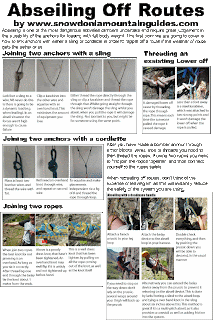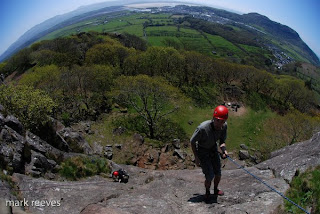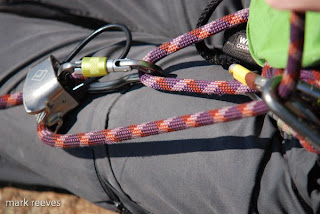
Wes Hunter Controlling the Anxiety on Poetry Pink E5 6a, Rainbow Slab.
In 1993 Jana Navotna was set to win wimbledon, she was 4-1 up in the final set, and then it all fell apart. The first sign of her collapse was a first service straight into the net, followed by a half hearted second serve, and a double fault. She quickly lost the service game and folded quickly receiving Steffi Graf’s serve, before losing successive game after successive game, barely winning a point and making numerous double faults. She had gone from potential hero to nothing in the space of a couple of minutes.
It was a classic example of anxiety’s ability to created what have become know as performance catastrophes. It is a facet of being human that sometimes when under pressure we ‘choke’, and our ability to perform even the most basic of tasks becomes agonisingly hard. In climbing that pressure becomes immense, as it literally becomes life or death in our minds.
* * *
Anxiety is often misunderstood and overlooked by climber, and in order to overcome its effects we must first understand what anxiety is and how it can effect us. Anxiety is hypothesised to have two dimensions one is in the mind and manifests itself as a worrying thoughts, this is referred to as cognitive anxiety, the other is the physiological effect of a burst of adrenaline.
Cognitive anxiety, stress or fear have an action on what is referred to as the Hypothamulus-Pituatary- Adrenal axis (HPA Axis). As the body senses danger, stress or worry a message is sent from the hypothamulus to the pituitary gland which in turn releases a hormone that makes the adrenal gland situated on the kidneys release adrenaline. This is often referred to as physiological arousal, as it has an effect on our bodies.
The body has several reactions adrenaline, which have typically been attributed to an evolved ‘fight or flight’ response. Where if meet with a challenge to our life the body rapidly prepares to fight the challenger or run from it. As such Adrenaline has various physiological effects. These are typified by opening up the arteries to the heart and skeletal muscles, and constricting those to that go to systems not essential to the fight or flight like the stomach and intestine. It also increases our breathing and heart rate, and increases the amount of blood glucose. It also stimulates protein catabolism which proves energy and readies the body to repair tissue. As such many of the physiological reactions will make us physically stronger and increase our endurance.
|
Cognitive
|
Somatic
|
Behavioural
|
Indecision
Sense of confusion
Feeling heavy
Negative thoughts
Poor concentration
Irritability
Fear
Forgetfulness
Loss of confidence
Images of failure
Defeatist self-talk
Feeling rushed
Feeling weak
Constant dissatisfaction
Unable to take instructions
Thoughts of avoidance |
Increased blood pressure
Pounding heart
Increased respiration rate
Sweating
Clammy hands and feet
Butterflies in the stomach
Adrenaline surge
Dry mouth
Need to urinate
Muscular tension
Tightness in neck and shoulders
Trembling
Incessant talking
Blushing
Pacing up and down
Distorted vision
Twitching
Yawning
Voice distortion
Nausea
Vomiting
Diarrhoea
Loss of appetite
Sleeplessness
Loss of libido |
Biting fingernails
Lethargic movements
Inhibited posture
Playing safe
Going through the motions
Introversion
Uncharacteristic displays of extroversion
Fidgeting
Avoidance of eye contact
Covering face with hand |
from http://www.brianmac.co.uk/companx.htm list of effects of adrenaline.
Whilst these are the physiological symptons of adrenaline, the way each person reacts or expereinces them is referred by psychologist as somatic arousal. If you like each individual will find various parts of the physiological reaction either facilitative or debilitative. Some people may well be overwhelm, whilst others won’t notice it. Typically the way we experience the physiological changes is butterflies in the stomach, fluttering heart rate, heavy breathing, sweaty palms, bodily tension and nerves.
Whilst it is impossible to stop the physiological arousal, we can learn to see it in a postive and facilitative way. However one of the biggest problems we as climbers face is that of cognitive anxiety. This is often the cause of our literal downfall, as when climbing we can be plagued by negative thoughts and self-talk, that prevent us from reaching our peak performance. It is often the cognitive side of anxiety that leads to the sudden drop in performance, there are several hypothesized reasons for the mechanics of the catastrophe.
Multi-dimension Anxiety Theory
This theory suggested that there was an invert U link to anxiety and performance, in that if you are under or over aroused then performance would be low, and that there is an optimum level of arousal for maximum performance.

Conscious Processing
Conscious processing which was a hypothesis put forward by Master 1992 that suggests that anxiety makes you over think an movement action, and in over thinking it, you stop that movement being automatic and instead revert to being a beginner. Sometimes referred to as paralyses by analysis.
Process Efficiency Theory
The process efficiency theory was put forward by Eysenck and Calvo who suggested that as anxiety increased the working memory would become overloaded with worry, and that because of this performance would drop. However in order to compensate for this reduction in processing efficency we increase the physical effort we put into a task to compensate.
Ironic Effects
Wegner came up with Ironic effect by experimenting with the repression or suppression of a thought and finding that by asking people not to think about a white polar bear they thought about it more. The argument being that if you try and not think about falling off, or failing that you will increase the occurrence of those negative thoughts, and potentially the likelihood of that happening.
Cusp Catastrophe Model
This is a complex model that suggest that under the specific conditions of somatic and cognitive arousal that performance suffer a steep and radical drop like dropping on the cusp of a wave. It also suggest that after that drop it will take a period of time at a lower arousal for performance to return to normal.

* * *
Reducing the fear factor
One of the most important things with understand anxiety is that we need to be able to try and control its effect on us. This is what the following section of the article looks at. Some tried and tested methods and some that are applications of other sport psychology techniques to that of climbing, and reducing the fear factor that we all feel from time to time.
An important consideration with fear is that it often occurs as a precursor to an activity, in that you are more likely to feel its effects both cognitively and somatically just before you embark on a climb. The cognitive worry prior to a climb will quickly subside, but the somatic influence may well continue.
Fall training
There have been several articles by Dave Binney in CLIMB magazine on the use of fall training to help overcome the fear of falling. Until a few years ago there was little scientific support for fall training, although a great deal of support from the real world experience of climbers. A few years back Steve Parry investigated one of Dave’s protocols in a scienctific fashion, and wrote his thesis on the findings. I was given an overview by Andy Boorman, senior lecturer at Liverpool John Moore University.
The overview gives some support to the fact that fall training can reduce the cognitive anxiety of someone by up to 50%. There is however several things that are worth noting in this research. The research had a small number of participants, so it is hard to see it as having a generalised effect. Similarly the only measure was cognitive anxiety, as the measure of somatic anxiety/physiological arousal failed. The test also only the effects in the very short-term, with individuals only being tested on one or possible two days (the methodology was vague in the overview I read).
As such there are questions as to whether fall training would have lasting effects, over several days, weeks or months? Similarly the use of the STAI as a anxiety measure was good, however the CSAI-2 measures both cognitive and somatic anxiety, as well as confidence, so may well have should some other more interesting results, like would confidence have a moderating effect on anxiety.
The further issue is that if the testing takes place over a short period, then cognitive anxiety is said to deminish short after we start an activity, so would cognitive anxiety naturally reduce over a short time period, therefore effecting the validity of the experiment because it could be hypthesised that cognitive anxiety would decreases anyway fall training or not.
Similarly physiological arousal would also have a ceiling level, as a feedback mechanism that as adrenaline levels reach a certain level in the blood, it effective switches off the release of anymore adrenaline, so the first few falls may max out our systems with adrenaline.
Whatever the case falling off often allows us to rationalise the process of falling off. Where before falling it is very, very scary prospect, but afterwards we realise that the fall isn’t as bad as we expect. It is perhaps this reason alone that makes the progressive fall training a great tool to help us come to terms with the fear, becasue at the very least it allows us to experience the somatic influence of adrenaline and to come to terms with how we react to it.
The general thought of the practical side of fall training is to progressive increase the distance of a fall from the rope being clipped into an anchor by your face to eventually below your feet. It is best to start this process inside on bolts, pick a gently overhanging wall, so there are no ledges or large hold to hit. Also the higher up the wall the better as the impact forces will be lower, as there is more rope out.
Finally make sure you trust your belayer, there is some research ongoing at the moment in the belayer/climber trust relationship. I am sure they will find a link between trust in the person holding your ropes and your performance.
Similarly be very careful if attempting fall training outside, as there are far greater risks like protection failing, ledges to hit, etc…
PMR and Imagery
Progressive Muscle relaxation was used in conjunction with imagery to help to desensitize people from fearful stimuli from as early as the 1940’s, where it has been proven to be effective. The general idea is that you use progressive muscle relaxation to find a zero activiation level, where you are totally relaxed. Once you have mastered the relaxation you then relax and add in the imagined fearful stimuli.
Ask yourself what your response to the fearful stimulus was, and we want to try and change that negative response to a positive one. So write a script, that has the fearful stimulus and the new positive response propositions. So whilst you might not be able to change the sinking feeling in your stomach, you can turn the idea of that sinking feeling to be a positive action that happens before the excitement of the climb.
When have your new script combine the relaxation and new imagery script.
Brief Relaxation stratgeies
Often before a route our worrying thoughts can over power us, similarly if we have a good rest before the crux move of a route then the anxiety can return. In order to help keep those worries at bay and help counteract the racing breathing and heart rate caused by anxiety, it is good to have a mental relaxation technique, that you can quickly use, to help focus of the here and now rather than what might or might might not happen.
The easiest thing to control to relax is the Breathing and if we use it in conjunction with a mantra like ‘re-lax’, where we use the ‘re’ during the inhalation and and ‘lax’ during the exhalation. At the same time choose a point to focus on, it might be a speck of rock, a piece of protection, just anything that will help you focus on your current position.
To start with many people will need to follow a complete relaxation exercise that lasts 20 minutes. Over a few session the amount of time that it takes you to relax will reduce, and over a couple of weeks of practice you might find that the time you take to relax may come down to 5 to 10 minutes. Eventually the breathing exercises will help to relax in a less than minute or two.
Self-talk strategies
Now we have mentioned that anxiety has a large cognitive component, it is therefore important that you understand what your negative thoughts are and how they effect you. This can be achieve by noting down negative thoughts that occur prior to falling or feeling that you are about to fall. Often people have a pattern of negative thoughts, they almost expect to fail as soon as they experience those thoughts.
In exploring you negative thoughts, ‘my hands are going to slip’, ‘My arms won’t pull me to the next hold’, ‘my foot is going to slip’, ‘I can’t find the next hand/foot hold’, ‘I can see a runner’, any or all of these might have an effect on your climbing. Whatever the thought or thoughts are you need to be ready for them, and have something up your sleeve to stop and counteract the negativity.
At its most basic you need to say “Stop!” when you get those negative thoughts, beyond that you need to add a counter argument. So for ‘My hands are going to slip’ you might counter with ‘Not before i reach that good rest beyond the crux’.
Similarly you can use self talk to attack the crux of a route, I often find myself reasonably calm on most parts of a route, but as I get to the crux I use the cue phrase ‘Go for it’. This mentally shifts to a place where I have accepted that i might fall off, but I am not going to stop before I get to the next rest, or that fall occurs.
The transistion is deliberate, and calculated, in that I have assessed that the gear is good enough to take a fall, and the next rest isn’t that far away that your going to hit the ground. Whilst this isn’t a controlling technique, it is a technique of acceptance, afterall you have decided to put yourself in that position.
In fact it fits in more with something called reversal theory, I am not sure of the scientific backing for such a theory, but it contested that we can if we wish to see something that is at first scary as something that is fun and exciting. It is this transforming of a situation from a negative experience to a positive one. If during the fall training you concentrate of whooping with joy every time you fall off them this may well help you ‘frame’ falling as fun.
Personal Training Programmes
If you are interested in a personalised training regime to help combat the fear of falling, or help to improve other aspects of your performance then contact the climbing coach via this website.












